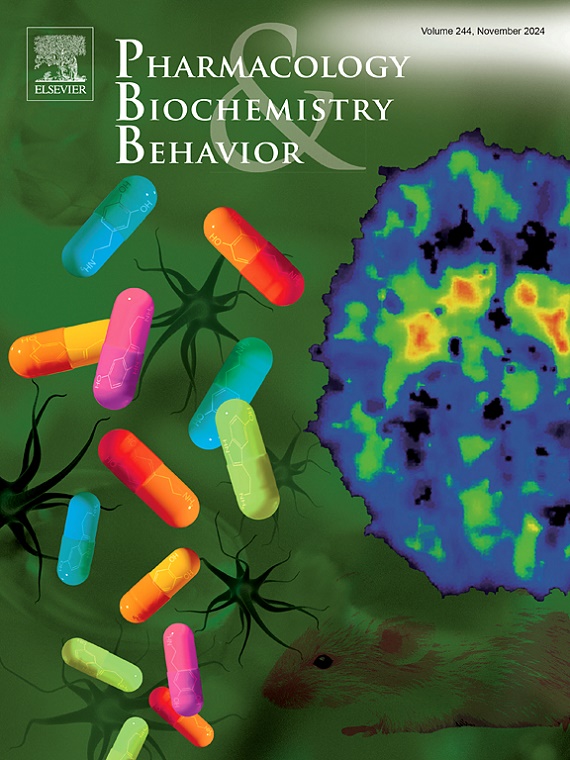妊娠期给予帕罗西汀影响雄性后代大鼠行为改变和海马细胞增殖
IF 3.3
3区 心理学
Q1 BEHAVIORAL SCIENCES
引用次数: 0
摘要
虽然在过去的几十年里,怀孕期间使用抗抑郁药的情况有所增加,但它们的安全性仍然是一个有争议的话题。选择性5 -羟色胺再摄取抑制剂(SSRIs)可以穿过胎盘并影响怀孕期间暴露的婴儿围产期结局。最近的研究表明,新的风险不仅是结构畸形,而且还包括后代的长期行为、发育和情绪障碍。目的:我们旨在阐明子宫内暴露于帕罗西汀可能影响帕罗西汀治疗的啮齿动物母亲后代的行为和海马的影响。方法妊娠雌性Wistar大鼠从胚胎期12.5 ~ 21天每天口服帕罗西汀。对照组给予帕罗西汀1 mg/kg/day或帕罗西汀2.5 mg/kg/day或生理盐水。在出生后第30天,我们用y迷宫测试评估了雄性后代的自发运动活动、自发交替行为,用升高正迷宫(EPM)评估了焦虑行为。荧光显微镜下计数海马中溴脱氧尿苷(BrdU)阳性细胞。结果与对照组相比,帕罗西汀2.5 mg组心肌运动活性明显增强。与对照组和帕罗西汀1 mg组相比,帕罗西汀2.5 mg组在EPM中的封闭臂时间更短。与对照组相比,paroxetine 2.5 mg组齿状回brdu阳性细胞数量明显增加。结论妊娠期口服帕罗西汀可诱导雄性后代多动、减轻焦虑、增加海马细胞增殖。本文章由计算机程序翻译,如有差异,请以英文原文为准。
Administration of paroxetine during pregnancy affects behavioral changes and hippocampal cell proliferation in male offspring in rats
Background
Although the use of antidepressants during pregnancy has increased over the last several decades, their safety has remained a topic of debate. Selective serotonin reuptake inhibitors (SSRIs) can cross the placenta and affect perinatal outcomes in infants exposed during pregnancy. Recent studies suggest new risks for not only for structural malformations, but also long-term behavioral, developmental, and emotional disorders in offspring.
Aim
We aimed to elucidate the effects by which in utero paroxetine exposure may affect the behavior and hippocampus of the offspring of paroxetine-treated rodent mothers.
Methods
Paroxetine was administered daily to pregnant female Wistar rats from embryonic day (ED) 12.5 to ED 21 with oral sondes. Paroxetine 1 mg/kg/day or paroxetine 2.5 mg/kg/day or saline was given to the control group. We evaluated spontaneous locomotor activity, spontaneous alternation behavior using the Y-maze test, and anxiety behavior using the elevated plus maze (EPM) in male offspring at postnatal day 30. Bromodeoxyuridine (BrdU)-positive cells in the hippocampus were counted using a fluorescence microscope.
Results
Locomotor activities significantly increased in the paroxetine 2.5 mg compared with the control group. The paroxetine 2.5 mg group spent less time in the closed arm than did the control and paroxetine 1 mg groups in the EPM. The number of BrdU-positive cells in the dentate gyrus was significantly increased in the paroxetine 2.5 mg compared with the control group.
Conclusions
These findings suggest that oral administration of paroxetine during pregnancy induces hyperactivity, decreases anxiety, and increases cell proliferation in the hippocampus of male offspring.
求助全文
通过发布文献求助,成功后即可免费获取论文全文。
去求助
来源期刊
CiteScore
6.40
自引率
2.80%
发文量
122
审稿时长
38 days
期刊介绍:
Pharmacology Biochemistry & Behavior publishes original reports in the areas of pharmacology and biochemistry in which the primary emphasis and theoretical context are behavioral. Contributions may involve clinical, preclinical, or basic research. Purely biochemical or toxicology studies will not be published. Papers describing the behavioral effects of novel drugs in models of psychiatric, neurological and cognitive disorders, and central pain must include a positive control unless the paper is on a disease where such a drug is not available yet. Papers focusing on physiological processes (e.g., peripheral pain mechanisms, body temperature regulation, seizure activity) are not accepted as we would like to retain the focus of Pharmacology Biochemistry & Behavior on behavior and its interaction with the biochemistry and neurochemistry of the central nervous system. Papers describing the effects of plant materials are generally not considered, unless the active ingredients are studied, the extraction method is well described, the doses tested are known, and clear and definite experimental evidence on the mechanism of action of the active ingredients is provided.

 求助内容:
求助内容: 应助结果提醒方式:
应助结果提醒方式:


